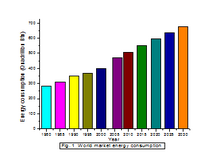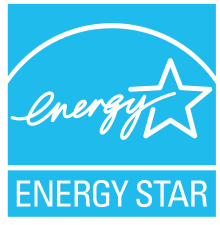
Energy Star is a program run by the U.S. Environmental Protection Agency (EPA) and U.S. Department of Energy (DOE) that promotes energy efficiency. The program provides information on the energy consumption of products and devices using different standardized methods. The Energy Star label is found on more than 75 different certified product categories, homes, commercial buildings, and industrial plants. In the United States, the Energy Star label is also shown on the Energy Guide appliance label of qualifying products.

Energy conservation is the effort to reduce wasteful energy consumption by using fewer energy services. This can be done by using energy more effectively or changing one's behavior to use less service. Energy conservation can be achieved through efficient energy use, which has some advantages, including a reduction in greenhouse gas emissions and a smaller carbon footprint, as well as cost, water, and energy savings.

Green building refers to both a structure and the application of processes that are environmentally responsible and resource-efficient throughout a building's life-cycle: from planning to design, construction, operation, maintenance, renovation, and demolition. This requires close cooperation of the contractor, the architects, the engineers, and the client at all project stages. The Green Building practice expands and complements the classical building design concerns of economy, utility, durability, and comfort. Green building also refers to saving resources to the maximum extent, including energy saving, land saving, water saving, material saving, etc., during the whole life cycle of the building, protecting the environment and reducing pollution, providing people with healthy, comfortable and efficient use of space, and being in harmony with nature. Buildings that live in harmony; green building technology focuses on low consumption, high efficiency, economy, environmental protection, integration and optimization.’

A low-energy house is characterized by an energy-efficient design and technical features which enable it to provide high living standards and comfort with low energy consumption and carbon emissions. Traditional heating and active cooling systems are absent, or their use is secondary. Low-energy buildings may be viewed as examples of sustainable architecture. Low-energy houses often have active and passive solar building design and components, which reduce the house's energy consumption and minimally impact the resident's lifestyle. Throughout the world, companies and non-profit organizations provide guidelines and issue certifications to guarantee the energy performance of buildings and their processes and materials. Certifications include passive house, BBC—Bâtiment Basse Consommation—Effinergie (France), zero-carbon house (UK), and Minergie (Switzerland).

Leadership in Energy and Environmental Design (LEED) is a green building certification program used worldwide. Developed by the non-profit U.S. Green Building Council (USGBC), it includes a set of rating systems for the design, construction, operation, and maintenance of green buildings, homes, and neighborhoods, which aims to help building owners and operators be environmentally responsible and use resources efficiently.
The Nationwide House Energy Rating Scheme (NatHERS) is an Australian scheme to measure the energy efficiency of a residential dwelling. An accredited software tool assesses the home based on a variety of criteria and produces an energy star rating.

A Zero-Energy Building (ZEB), also known as a Net Zero-Energy (NZE) building, is a building with net zero energy consumption, meaning the total amount of energy used by the building on an annual basis is equal to the amount of renewable energy created on the site or in other definitions by renewable energy sources offsite, using technology such as heat pumps, high efficiency windows and insulation, and solar panels.
Domestic housing in the United Kingdom presents a possible opportunity for achieving the 20% overall cut in UK greenhouse gas emissions targeted by the Government for 2010. However, the process of achieving that drop is proving problematic given the very wide range of age and condition of the UK housing stock.

Energy World was a demonstration project of 51 low-energy houses constructed in the Shenley Lodge area of Milton Keynes, United Kingdom. The project was promoted by the Milton Keynes Development Corporation and culminated in a public exhibition in August and October 1986 that attracted international interest. It was a significant landmark in the design and construction of low-energy housing, and in the development of energy efficiency evaluation tools. It has had a long-term impact on Government policy and within the national house-building industry, insofar as the progressive 'tightening up' of the energy section of the Building Regulations has largely been founded on this pioneering work.
The National Home Energy Rating Scheme (NHER) is both a UK accreditation scheme for energy assessors and a rating scale for the energy efficiency of housing.
The Code for Sustainable Homes was an environmental assessment method for rating and certifying the performance of new homes in United Kingdom. First introduced in 2006, it is a national standard for use in the design and construction of new homes with a view to encouraging continuous improvement in sustainable home building. In 2015 the Government in England withdrew it, consolidating some standards into Building Regulations.

Energy performance certificates (EPCs) are a rating scheme to summarise the energy efficiency of buildings. The building is given a rating between A - G (Inefficient). The EPC will also include tips about the most cost-effective ways to improve the home energy rating. Energy performance certificates are used in many countries.

An energy performance certificate (EPC) is a rating scheme to summarise the energy efficiency of buildings or devices.

Efficient energy use, sometimes simply called energy efficiency, is the process of reducing the amount of energy required to provide products and services. For example, insulating a building allows it to use less heating and cooling energy to achieve and maintain a thermal comfort. Installing light-emitting diode bulbs, fluorescent lighting, or natural skylight windows reduces the amount of energy required to attain the same level of illumination compared to using traditional incandescent light bulbs. Improvements in energy efficiency are generally achieved by adopting a more efficient technology or production process or by application of commonly accepted methods to reduce energy losses.
The Home Energy Rating is an American estimated measurement of a home's energy efficiency based on normalized modified end-use loads (nMEULs). In the United States, the Residential Energy Services Network (RESNET) is responsible for creation and maintenance of the RESNET Mortgage Industry National Home Energy Rating Standards (MINHERS), a proprietary system of standards, which includes standards language for the certification and quality assurance for RESNET Provider organizations. RESNET is an EPA recognized Home Certification Organization (HCO) that also help's create standards in compliance with the American National Standards Institute, namely ANSI 301, ANSI 310, ANSI 380, and ANSI 850. The Building Science Institute, Ltd. Co. (BSI) is another EPA recognized HCO that maintains the ANSI Standards to produce Energy Ratings and compliance with above-code programs such as the ENERGY STAR New Homes Program.
A Domestic Energy Assessor (DEA) for efficient energy use is an accredited position in the UK that is approved by the Ministry for Housing, Communities and Local Government (MHCLG). Under the UK's Energy Performance of Buildings Regulations, an Energy Performance Certificate is required for the sale or rent of a domestic dwelling. DEAs are qualified and accredited for the production of RdSAP EPCs - these are specifically for use on existing buildings, which would include an dwelling built after 2008 which had already received an on-construction SAP EPC. As of November 2018, DEAs had produced 16,849,375 RdSAP EPCs since the inception of the industry.

The Bureau of Energy Efficiency is an agency of the Government of India, under the Ministry of Power, created in March 2002 under the provisions of the nation's 2001 Energy Conservation Act. The agency's function is to encourage the efficient use of energy in India by developing programs to support it. For example, the government proposed to make it mandatory for certain appliances in India to have ratings by the BEE from January 2010 onwards. The mission of the Bureau of Energy Efficiency is to institutionalise energy efficiency services, enable delivery mechanisms in the country and provide leadership to energy efficiency in all sectors of the country. Its primary objective is to reduce energy intensity in the economy.
Green building on college campuses is the purposeful construction of buildings on college campuses that decreases resource usage in both the building process and also the future use of the building. The goal is to reduce CO2 emissions, energy use, and water use, while creating an atmosphere where students can be healthy and learn.

In Australia and New Zealand, an energy rating label or energy rating is a label affixed to various appliances prior to retail sale, which allows consumers to compare the energy efficiency of product and allows consumers to know how much power a particular model will use to run. They allow consumers to compare the energy consumption of similar products, and factor lifetime running cost into their purchasing decision. The energy rating label is a mandatory comparison label under Australian regulations for store sales but not for products sold online. The label comprises an energy consumption figure for the appliance and a star rating. The energy consumption figure is an estimate of how much energy the appliance will use over a year, based on assumptions about "average usage".
Public plans for energy efficient refurbishment are put in place by states to encourage building owners to renovate their properties in a way that increases their energy performance. As financing represents the most important obstacle to this type of renovation, the plans favour financial incentives in the form of loans or grants. Various institutions can be involved in the process, such as ministries, banks, firms, or energy services companies (ESCOs).













